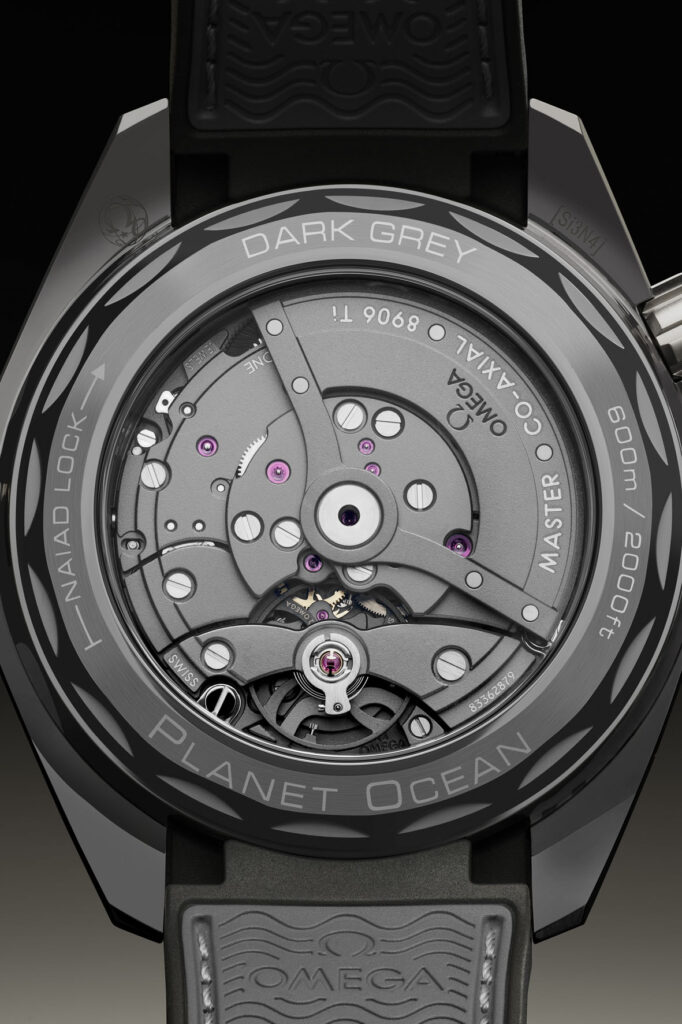Omega Seamaster Planet Ocean Dark Grey: la rivoluzione dei materiali
23 December 2023When it comes to pushing research, Omega certainly doesn’t shy away from it. Indeed, the brand has a history, not only recent, of great experimentation – especially with new materials. Experimentations that affect all parts of the watch, from the case to the dial to the movement and its parts. The recent Seamaster Planet Ocean Dark Grey is an example of Omega’s vocation for research.
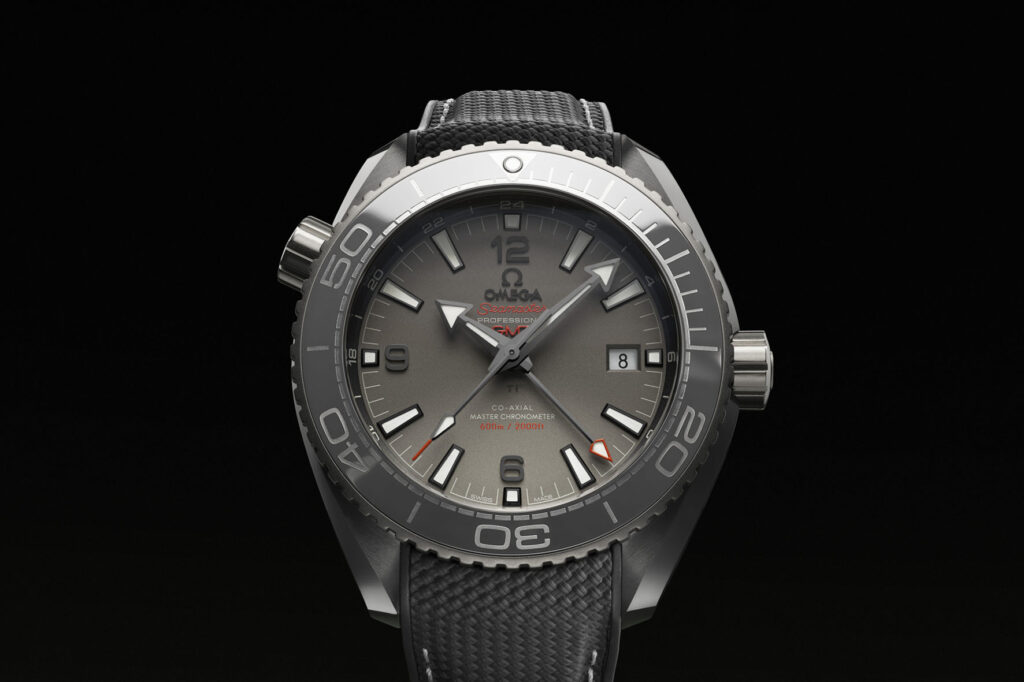
Already last January, the Biel-based brand inaugurated 2023 with a major technical innovation: a balance spring that allowed very fine adjustments to the watch’s rate thanks to the new patent-pending Spiratetechnology; a system that allowed the watch to achieve the certified accuracy of 0/+2 seconds per day. This solution led to completely re-engineering the silicon balance spring to allow Omega’s watchmakers to intervene on the rigidity of its attachment point by acting on an off-center adjustment mechanism located on the balance bridge.
In that case, the innovation was at the very heart of the movement, but Omega is also and above all recognized for its research on case materials. Leaving aside, for the sake of brevity, the details on the many patented gold alloys (Sedna, Moonshine, Canopus), let’s recall that the brand has been employing ceramic for cases and dials for years. It is precisely ceramic that we are talking about for the new Seamaster Planet Ocean Dark Grey – but a special kind of ceramic.
SILICON NITRIDE
That is silicon nitride ceramic, a first for Omega. For those unfamiliar with chemistry, formulas and balancing, here are a few hints about this material. It is composed of silicon and nitrogen (its chemical formula is Si3N4), and regarding what we are interested in – namely its use in watchmaking – it presents some very interesting characteristics.
To begin with, it is chemically inert, very resistant to oxidation, resistant to thermal shock and wear. Then, not an insignificant detail, it has a low density and is therefore very light: 60 percent lighter than steel and twice as light as the zirconium oxide-based ceramic that Omega uses on some Seamasters. In addition, it is extremely hard. Its hardness value is 8.5 on the Mohs scale, at the top of which is diamond, that is rated at 10.
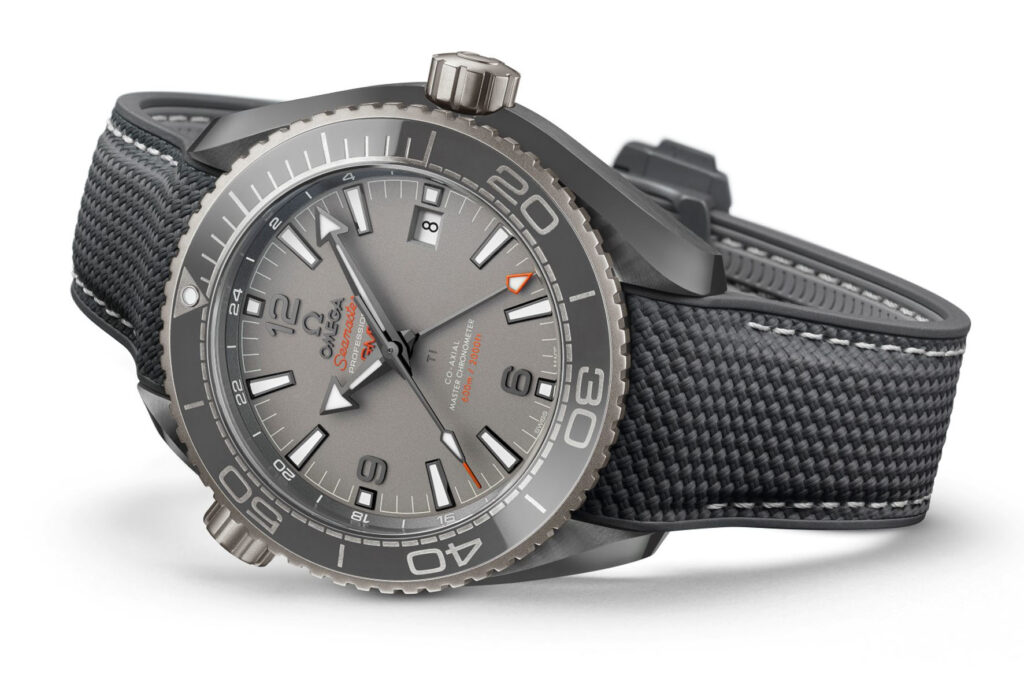
Not surprisingly, then, silicon nitride is used to produce high-strength automotive components, pipes, conduits, fittings and components for electrical signal transmission, and in various applications in the aerospace industry. Omega has decided to introduce it into watchmaking, and to do so it has chosen the Seamastercollection, which has always been devoted to experimentation and was designed from its inception to be a line destined to push the frontiers of exploration. Both geographical ones and those of materials, as evidenced by watches such as the Aqua Terra Ultralight in titanium or the Planet Ocean Ultra Deep in O-Mega Steel. Now, after titanium and special steel, it is the turn of the ceramic of the Seamaster Planet Ocean Dark Grey’s case.
MIX OF MATERIALS FOR OMEGA
The watch owes its name precisely to the characteristic color of the ceramic, and presents all the characteristic features of the Planet Ocean line. The case has the important diameter of 45.5 mm, a thickness that feels good on the wrist (17.4 mm), and is water-resistant to 60 bar. Its tripartite structure, which characterizes the Seamaster collection, is complemented by the very short integrated lugs, which in combination with the strap aim to improve the wearability of the watch as much as possible.
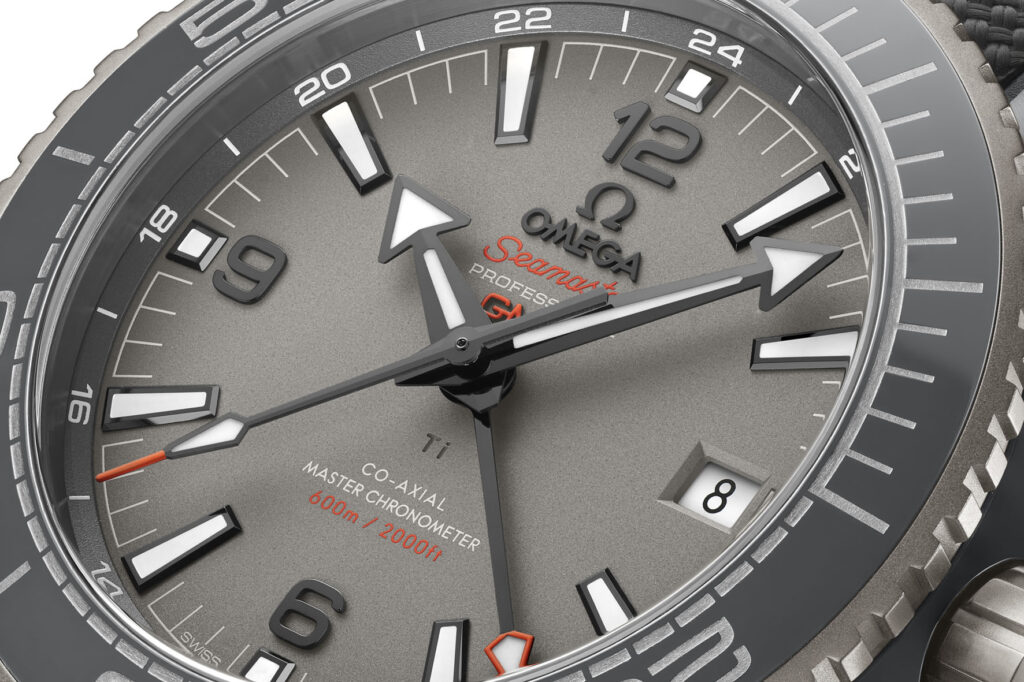
While the structure of the case is the classic one, it does not mean, however, that Omega has devoted little attention to it. Quite the contrary, indeed. Its various parts are characterized by a mixture of materials whose use is always aimed at making the watch as light as possible. The silicon nitride case middle is matched by the case back and bezel insert in the same material, as well as a series of Grade 5 titanium elements: the unidirectional rotating bezel, the crown, and the helium release valve. The sapphire crystal on the case back and dial also combine lightness and strength. All this makes the new Omega Seamaster Planet Ocean Dark Grey weigh just over an ounce, 107 grams, including the movement.
AN ADVANCED GMT
Also contributing to the lightness is the dial, made of grade 5 titanium as well. In addition to the gloomy color, what sets it apart is the delicate sandblasted finish that adds to the preciousness of its aesthetic. The hour markers are applied, generously sized as befits a professional dive watch; their outline is in an anthracite shade and the inner part is generously covered with luminescent material. The same material covers the tips and inner parts of the hour and minute hands, and the tips of the central seconds hands and GMT indicator.

This watch, in fact, also has a GMT function, which is well indicated by the orange lettering applied below the logo at 12 o’clock and complemented by the 24-hour indication on the inner flange of the dial. The dial’s orange touches provide sporty details: the ‘Seamaster’ and ‘GMT’ inscriptions at 12 o’clock, the water-resistance indication at 6 o’clock (600 m / 2000 ft), and the tips of the seconds and GMT hands.
Also contributing to the Omega Seamaster Planet Ocean Dark Grey’s lightness is the strap. It is made of a black and gray textured rubber with contrasting white stitching, and a grade 5 titanium folding clasp with an interesting satin finish. A non-trivial work for such a small and seemingly minor part of the watch, what’s more, in a metal that is by no means easy to finish: a further demonstration of the care that Omega put into this timepiece.
THE CALIBER, OMEGA’S SIGNATURE
The watch movement is the Omega Co-Axial Master Chronometer caliber 8906. This is the GMT-function version of the 8900, which was the Biel-based company’s first movement to receive chronometer certification from METAS, the Swiss metrology institute. It has the Co-Axial escapement, two barrels mounted in parallel, a free-sprung balance wheel with silicon balance spring. It is in fact the state of the art in Omega’s GMT movements.
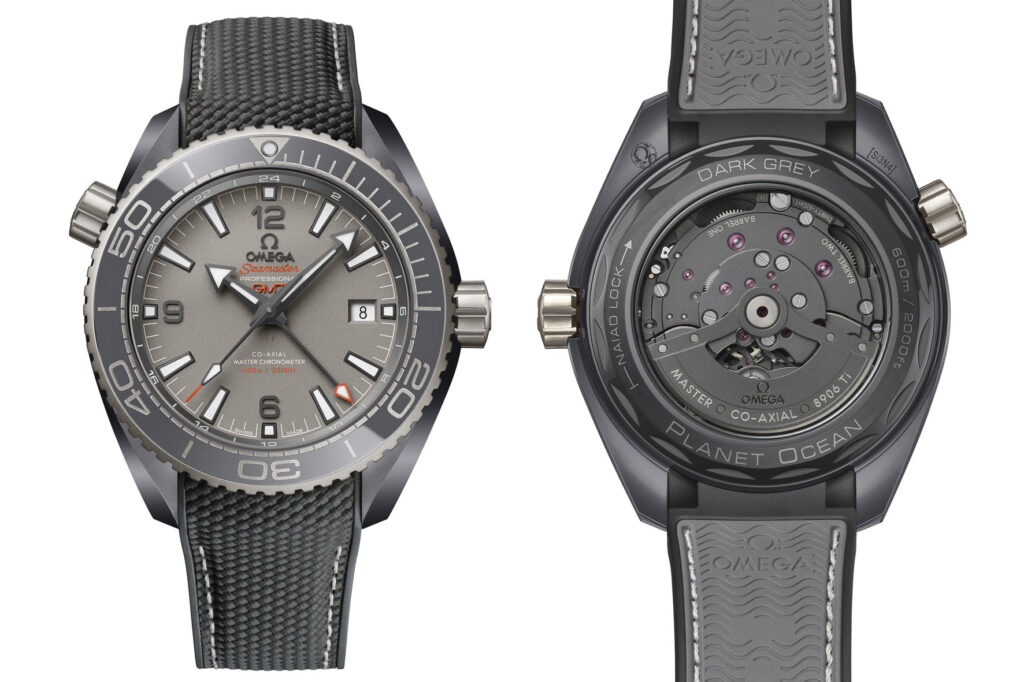
It operates at 25,200 vibrations per hour, and has a heavy metal oscillating weight so as to optimize winding efficiency and timing. When fully wound, it offers a 60-hour power reserve. It is resistant to magnetic fields of up to 15,000 gauss.
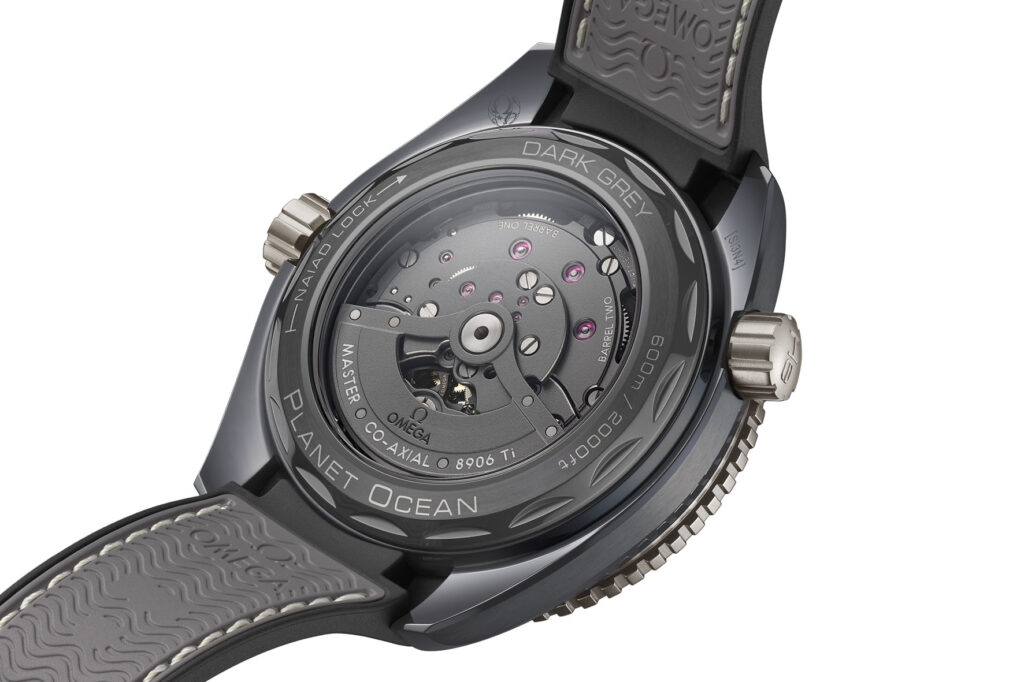
Omega brought special attention to its finishing. This self-winding movement echoes the dark gray of the entire watch in the bridges’ and the main plate’s colour, both in ceramized grade 5 titanium. While it does not have obvious or classic decorations like the côtes de Genève, it has a subtle grené finish that echoes that of the titanium dial. It is not handmade but, as might be expected from a highly industrialized brand such as Omega, is achieved using laser ablation.
TOP OF THE LINE
The Omega Seamaster Planet Ocean Dark Grey is not a limited or numbered edition, but it has one feature worth noting: it is the most expensive watch in the Planet Ocean line among those not made of precious metals or decorated with precious stones. In fact, it costs 24,900 euros, a significant figure for a GMT diver.
A figure justified by several reasons, one of them being precisely the silicon nitride ceramic. It is indeed a rather expensive material to produce, because it requires non-trivial industrial processes. Understandable, then, that its use could make the final price of the watch climb. Perhaps, however, it could also raise its value over time: it would be the market’s just recognition of Omega’s commitment to pushing the limit of research in haute horology further and further.
By Davide Passoni


